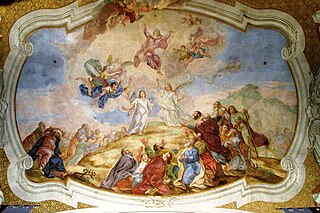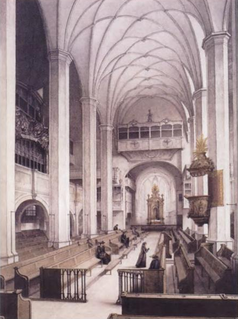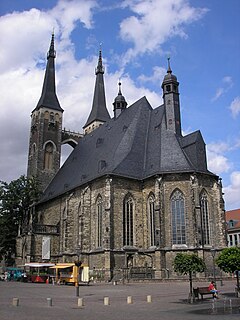
The Toccata and Fugue in D minor, BWV 565, is a piece of organ music written, according to its oldest extant sources, by Johann Sebastian Bach (1685–1750). The piece opens with a toccata section, followed by a fugue that ends in a coda. Scholars differ as to when it was composed. It could have been as early as c. 1704. Alternatively, a date as late as the 1750s has been suggested. To a large extent, the piece conforms to the characteristics deemed typical of the north German organ school of the Baroque era with divergent stylistic influences, such as south German characteristics.

The title Notebook for Anna Magdalena Bach refers to either of two manuscript notebooks that the German Baroque composer Johann Sebastian Bach presented to his second wife, Anna Magdalena. Keyboard music makes up most of both notebooks, and a few pieces for voice are included.

The French Suites, BWV 812–817, are six suites which Johann Sebastian Bach wrote for the clavier between the years of 1722 and 1725. Although Suites Nos. 1 to 4 are typically dated to 1722, it is possible that the first was written somewhat earlier.

Lobet Gott in seinen Reichen, BWV 11, known as the Ascension Oratorio, is an oratorio by Johann Sebastian Bach, marked by him as Oratorium In Festo Ascensionis Xsti, probably composed in 1735 for the service for Ascension and first performed on 19 May 1735.

Johann Sebastian Bach was a German composer and musician of the late Baroque period. He is known for instrumental compositions such as the Cello Suites and Brandenburg Concertos; keyboard works such as the Goldberg Variations, The Well-Tempered Clavier and the Toccata and Fugue in D minor; and vocal music such as the St Matthew Passion and the Mass in B minor. Since the 19th-century Bach Revival, he has been generally regarded as one of the greatest composers in the history of Western music.

Johann Sebastian Bach composed the church cantata Ein ungefärbt Gemüte, BWV 24 in Leipzig for the fourth Sunday after Trinity and first performed it on 20 June 1723. It is the third new cantata of his first cantata cycle in Leipzig. The title has been translated more freely, for example as "An unstained mind", "An unblemished conscience", "An undisguised intention", and "An unsophisticated mind".

Herr Gott, Beherrscher aller Dinge, BWV 120.2, is a wedding cantata by Johann Sebastian Bach. He composed and first performed it in Leipzig, most likely in 1729.

Der Herr denket an uns, BWV 196, is a cantata by Johann Sebastian Bach. The early church cantata, possibly for a wedding, is difficult to date, but is generally considered to be an early work on stylistic grounds. The text is a passage from Psalm 115, assuring of God's blessing, especially for children. Scholars have suggested the work may have been written for the wedding of Johann Lorenz Stauber, the minister in Dornheim who had married Bach and his first wife there in 1707, and Regina Wedemann, an aunt of Bach's wife, on 5 June 1708.

Nun danket alle Gott, BWV 192, is a church cantata for Trinity Sunday composed by Johann Sebastian Bach in Leipzig in 1730. It is an incomplete cantata, because its tenor part is missing. It is a chorale cantata, setting the unmodified three stanzas of Martin Rinckart's "Nun danket alle Gott". It has been regarded as an expansion of Bach's chorale cantata cycle.
Weichet nur, betrübte Schatten, BWV 202, is a secular cantata by Johann Sebastian Bach. It was likely composed for a wedding, but scholars disagree on the dating which could be as early as Bach's tenure in Weimar, around 1714, while it has traditionally been connected to his wedding to Anna Magdalena on 3 December 1721 in Köthen. It is one of Bach's frequently recorded cantatas. The aria "Sich üben im Lieben" is often performed as a concert piece.

Lobet den Herrn, alle seine Heerscharen, BWV 1147, BWV Anh. 5, is a church cantata text by Christian Friedrich Hunold which was performed, most likely in a setting by Johann Sebastian Bach, for the twenty-fourth birthday of Prince Leopold of Anhalt-Köthen on 10 December 1718. The composition is lost, but its libretto survives in a 1719 print.
The Prelude and Fugue in F minor, BWV 881, is a keyboard composition written by Johann Sebastian Bach. It is the twelfth prelude and fugue in the second book of The Well-Tempered Clavier, a series of 48 preludes and fugues by the composer.

BWV Anh., abbreviation of Bach-Werke-Verzeichnis Anhang, is a list of lost, doubtful, and spurious compositions by, or once attributed to, Johann Sebastian Bach.

Johann Sebastian Bach started composing cantatas around 1707, when he was still an organist in Arnstadt. The first documented performances of his work took place in Mühlhausen, where he was appointed in 1708.
Picander's cycle of 1728–29 is a cycle of church cantata librettos covering the liturgical year. It was published for the first time in 1728 as Cantaten auf die Sonn- und Fest-Tage durch das gantze Jahr. Johann Sebastian Bach set several of these librettos to music, but it is unknown whether he covered a substantial part of the cycle. This elusive cycle of cantata settings is indicated as the composer's fourth Leipzig cycle, or the Picander cycle.
Late church cantatas by Johann Sebastian Bach refers to sacred cantatas he composed after his fourth cycle of 1728–29. Whether Bach still composed a full cantata cycle in the last 20 years of his life is not known, but the extant cantatas of this period written for occasions of the liturgical year are sometimes referred to as his fifth cycle, as, according to his obituary, he would have written five such cycles – inasmuch as such cantatas were not late additions to earlier cycles, or were adopted in his oratorios.











